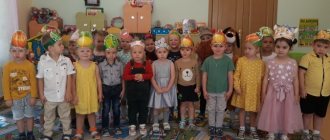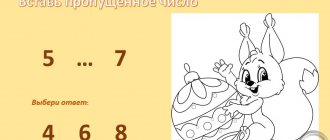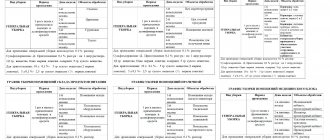How to make physical education more interesting and accessible for children? It is known: a positive emotional attitude contributes to faster assimilation of any material. The inclusion of riddles, counting rhymes, and sayings in physical education classes contributes to the development of interest in imitative exercises, as well as the desire to imagine and show in motion what you heard: it turns out that a riddle can not only be guessed, but also shown!
Imaginative play movements develop the ability to improvise, hearing, attention, thinking, creative imagination and memory. They reveal images that children can understand and develop the ability to creatively convey the character and habits of the depicted animal. In addition, by practicing such movements, children develop strength, dexterity, coordination of movements , learn to navigate in space, and acquire the skill of moving at a given pace and rhythm.
Taking into account all of the above, the teacher needs to take a creative approach to organizing classes, learn imitative movements in advance, prepare pictures depicting animals, talk about the habits of animals, where (in which countries) they live, select phonograms (low rhythmic music, recordings of noise effects, including onomatopoeia) that children must imitate, for example, the croaking of frogs, the meowing of a cat, the growling of a bear, etc.
We offer several options for riddle exercises, where funny imitative exercises serve as the answers.
Riddle next to the charger
1. Lightly run on your toes, arms to the sides, smoothly raise them high up and lower them down.
It flutters and dances over the flower, waving its patterned fan. All four petals of the flower were moving, I wanted to pick it, - It fluttered and flew away. (Butterfly)
2. Walking on the outside of your feet. Hands are spread wide apart. The steps are slow and clumsy.
Who, having forgotten his worries, Sleeps in his den? In the summer he wanders without a path near the pines and birches, and in the winter he sleeps in a den, hiding his nose from the frost? (Bear)
3. Sit down, straighten your back, heels slightly raised above the floor, hands on your knees. Move forward on your toes without losing your balance.
I swam in the water, but remained dry. He walks importantly across the meadow, comes out of the water dry, wears red shoes, gives soft featherbeds. (Goose)
4. Running or walking with high knees. Side or straight canter.
I knock and knock with my hooves And I gallop and gallop across the field, My mane curls in the wind... Who is it? (Horse)
5. Sit on the pet with emphasis on your knees and palms. Lean forward, bending your elbows (movements that imitate a cat crawling under a fence).
The muzzle is mustachioed, the fur coat is striped, He washes himself often, but he doesn’t know how to handle water. (Cat)
6. Lie on the floor. Crawl with support on your hands, try to keep your legs together.
In the rivers of Africa lives an evil, green steamboat. No matter who swims towards him, he will swallow everyone... (Crocodile)
7. Walking with high knees, arms high up, then down.
This is an old friend of ours, He lives on the roof of a house, He flies to hunt for frogs, to the swamp. (Stork)
8. Walking on your heels with rhythmic movements of your arms to the sides.
Yellow lumps, as light as cotton wool, running after the quack. Who is this? (Chicks)
9. Fast, rapid running; arms spread wide apart, fingers spread out.
A bird flies from above and there are plenty of chickens below. (Hawk)
10. Sit on the floor, knees to the sides, heels slightly raised above the floor, hands in front. Jump forward slowly.
A frog jumps, Not a mouth, but a trap, Both a mosquito and a fly fall into the trap. (Frog)
11. Lie on your back. Raise yourself slightly and move backwards using your arms and legs.
People live under water and walk backwards. (Cancer)
12. Jumping on two legs while moving forward. The arms are bent in front of the chest, the hands are down.
Jump-jump, jump-jump, Long ear - white side. (Hare)
13. Lean forward, move your arms back, make movements that imitate pecking grains.
Chick-chirp, Jump to the grains, Peck, don’t be shy! Who is this? (Sparrow)
14. Get down on your knees. Move forward with support on your knees and elbows.
He made a hole, dug a hole, the sun is shining, but he doesn’t even know. (Mole)
15. Easy running on your toes. Arms to the sides, hands “tremble” slightly.
It chirps with its wings from evening to night. (Dragonfly)
16. Sit down a little. Small jumps forward on two legs.
He lives in a hollow and chews nuts. Jumping along the branches, but not a bird, Red, not a fox. (Squirrel)
17. Lie on the floor on your stomach, hands resting on the floor, knees bent. Bend over and stretch your toes towards your head without straightening your elbows.
It has wings, but doesn’t fly, No legs, but you can’t catch up. Parents and children have all their clothes made of coins. (Fish)
18. Walk quickly on your toes with small mincing steps.
A little ball rummages around under the bench, lives in a hole, gnaws on crusts, has short legs, is afraid of the cat. (Mouse)
19. Jump forward, crossing your arms at the top like horns.
Who wears a forest on their head? (Deer)
20. Walking on toes, legs straight, arms raised up, hands connected. Try to keep your arms outstretched behind your ears and do not lower your chin.
He walks with his head raised, Not because he is an important count, Not because he has a proud disposition, But because he... (giraffe).
21. Large circular movements with your arms in front of you.
She flaps her wings, but she doesn’t move. (Mill)
22. Easy running around the hall. Join your hands at the top.
There are no clouds on the horizon, But an umbrella opened in the sky, A few minutes later It descended... (parachute).
23. Sit on the floor, clasp your bent knees with your hands, lower your head - group. Rolls back, onto your back and return to the starting position.
Mixed with sour cream, Cold on the window, Round side, ruddy side, Rolled... (bun).
24. Join your hands at the top, elbows to the sides. Stretch up on your toes.
If we don’t leave him at home, then we won’t melt in the rain. (Umbrella)
As children master the technique of performing movements, they can take turns asking riddles themselves. Such fun and amusing “riddles with exercises” can be used in morning exercises, during physical education, during musical and physical education activities.
Not just for children
In fairness, it is worth noting that adults also like such training. Everyone knows the “Games of Five Animals” of the Qigong system - imitation of the movements and habits of a tiger, bear, deer, monkey and bird - which takes about two thousand years to maintain health
In addition, one of the fashionable modern trends in fitness is Animal Flow, which is based on imitation of the movements of animals, birds and insects. There is something bewitching, primitive in this, reminiscent of the ritual dances of the power of primitive ancestors around the fire.
Photo: depositphotos
An active game with a hero character
It is known that children love to play outdoor games, which are active and meaningful activities for them. The content of outdoor games, as a rule, is educational material that expands the child’s horizons. To achieve greater interest in children and encourage them to take part in such games, the teacher needs to create a joyful, relaxed atmosphere in the classroom and come up with funny stories.
Often, for sports events or leisure activities, an active game with a hero-character is necessary. It’s not difficult to come up with such a game yourself based on riddles, poems, sayings. In its course, you may need large bright toys (Bear, Fox, Dog), inflatable or made of artificial fur, as well as animal masks.
Monologue of a student
The same school, the same class, subject to the same classics. The same meaning of all the same phrases On the lips of the same class. And for the umpteenth time I observe the same walls... How the expectation of change brings them and us closer together! Everything is still the same for now, I don’t know one thing for sure: Either I’ll get enough sleep before the bell rings, Or they’ll kick me out early.
When Oleg Gennadyevich Paramonov wrote these poems while still a schoolboy, he had absolutely no intention of becoming a teacher. But fate so happened that he became a teacher and, after re-reading these poems, he suddenly realized that he had to work in such a way that his student would never have such thoughts in his head. And for this you need to do it in a way that makes it interesting.
After all, children understand everything when they are interested. It must be borne in mind that “interest” (according to I. Herbert) is a synonym for educational motivation. If we consider all learning in the form of a chain: “I want - I can - I do it with interest - personally - meaningfully,” then we again see that interest is at the center of this structure.
It is not enough for a child to say that he needs knowledge of mathematics, he must feel it, he needs to lose, to live through the situations that life will put before him.
It is necessary to teach children to think, including business, feeling, emotions in their activities - this is the area in which a holistic personality develops.
Activating the cognitive activity of students is one of the most basic tasks of a teacher. Among all the motives of educational activity, the most effective is the cognitive interest that arises in the learning process. It not only activates mental activity at the moment, but also directs it to the subsequent solution of various problems. Sustained cognitive interest is formed by various means.
Motivation for a student’s cognitive activity in the classroom can be achieved by relying on life experience; children understand and are interested in the tasks associated with the work of parents. It is very important that the teacher has an attitude: to link any material being studied to life, to show its significance. When selecting material for a lesson, I always think through points that show why it is very important to know.
First of all, it should be said that the goal of mathematics education is the cultural development of students. It is necessary to teach children to value the spiritual and material wealth accumulated by humanity, but from the point of view of motivation, the question can be put differently: “a person who has not received a decent mathematical education cannot be considered cultural.” First of all, the teacher himself must believe in the potential possibilities mathematics contains. This is spiritual, aesthetic, creative and intellectual development.
When teaching mathematics, a didactic game comes to the aid of the teacher. Even with planned success, the game gives students insight, intellectual pleasure, and a surge of positive emotions. Thanks to planning and solving problem situations of the game, the student becomes a confident thinking person, capable of active action.
The teacher’s task is to teach each child to learn independently, to develop in him the need to be active in the learning process.
The game helps to avoid annoying edification and creates an atmosphere of friendliness in the children's team. There should be no dullness and monotony in games for schoolchildren. The game should constantly replenish knowledge and be a means of comprehensive development of the child and his abilities.
Work and study, combined with play activities, contribute to the formation of character and the development of will. The efforts (physical and mental) that a child makes in the game are fruitful, since in the game, unnoticed by himself, he develops a number of skills that will later be useful to him in life. Thus, games lead to the systematization of life experience, are a release for the nervous system, develop initiative and resourcefulness, teach work, precision, accuracy and perseverance in overcoming obstacles.
V.A. Sukhomlinsky wrote: “Let us take a closer look at what place play occupies in a child’s life. For him, playing is the most serious matter. In play, the world is revealed to children, the creative abilities of the individual are developed... Play is a huge, bright window through which a life-giving stream of ideas and concepts about the surrounding world flows into the child’s spiritual world.”
I would like to talk separately about the methodology for preparing and conducting simulation games in mathematics lessons.
— What is “imitation”?
The simulation game occupies one of the main places in the structure of didactic games.
Its subject is concrete human activity itself in all its manifestations. The main means of this game is to play a role in a simulation model of a specific situation.
Achieving the goal of the game satisfies the cognitive needs of the player, which are reflected in the independent prediction of the results of the game and are expressed in the obvious assimilation of the content and methods of the simulated activity.
The general structure of the simulation game includes the following components:
- a need or motivation to satisfy which a specific activity is aimed;
- activity items and/or item substitutes;
- independent actions with objects or their substitutes;
- performance results (one's own and others' achievements).
Methodology of preparation and conduct
- Development of a scenario - a conditional representation of the situation and the object. The content of the scenario includes: the educational purpose of the lesson, a description of the problem being studied, justification for the task, a plan for the didactic game, the content of the situation and the characteristics of the characters.
- Introduction to the game, orientation of participants and experts. The mode of operation is determined, the main goal of the lesson is formulated, the situation of the problem and the choice of situation are justified. Packages of materials, instructions, rules, and guidelines are issued. Additional information is being collected. If necessary, students turn to the facilitator and experts for advice. Preliminary contacts between game participants are allowed. Unspoken rules prohibit refusing the role assigned by lot, leaving the game, being passive in the game, suppressing activity, and violating regulations and ethical behavior.
Game process
The host can correct the actions of the participants if they move away from the main goal of the game. Depending on the modification of the didactic game, various types of role positions of participants can be introduced: idea generator, developer, imitator, scholar, diagnostician, analyst.
Stage of analysis, discussion and evaluation of game results
Expert presentations, discussions and evaluation of the game results. Expert presentations, exchange of opinions, students defending their decisions and conclusions; the teacher’s statement of the results achieved, the analysis of mistakes made, the formulation of the final outcome of the lesson, the establishment of a connection between the game and the content of the subject. In particular, the game contributes to the development of discipline, because any game is played according to the appropriate rules. When joining the game, the student follows certain rules; at the same time, he obeys the rules themselves not under duress, but completely voluntarily, otherwise there will be no game. And following the rules is associated with overcoming difficulties and with perseverance.
When organizing simulation games, you must adhere to the following provisions:
- The rules of the game should be simple, precisely formulated, and accessible to younger students. If the material is feasible only for certain students, and the rest either do not understand the rules or have little understanding of the content of the mathematical or logical side of the game, then it will not arouse the interest of children and will be carried out only formally.
- When conducting a game, control over its results must be ensured by the entire team of students present. Accounting of results must be open, clear and fair. Errors in accounting, ambiguities in the organization of accounting itself lead to unfair conclusions about the winners, and, consequently, to dissatisfaction among the participants in the game. Games will be interesting for children when each of them becomes an active participant.
- In mathematics lessons, games have cognitive significance, therefore, they bring to the fore a mental task, for the solution of which comparisons, analysis and synthesis, judgments and inferences must be used in mental activity. Then they will contribute not only to the formation of logical thinking in younger schoolchildren, but also to correct, clear, and concise speech.
- During the game, a certain completed action must be performed, a specific task must be solved. The game should not be left unfinished. Only under these conditions will she leave a mark in the minds of the children.
A simulation game is an active independent activity that acts in the educational process as an effective means of theoretical and experimental preparation of the student player’s thinking for the upcoming practical activity. List of used literature:
- Bogachenko, E.A. Game as a modern method of education [text] / E.A. Bogachenko // Primary school. — 2010. — No. 6. — 18 p.
- Gazman, O.S. The role of games in the formation of a schoolchild’s personality [text] // O.S. Gazman - M.: Pedagogy, 2012. - No. 9. - 64 p.
- Shmakov, S.A. Students’ games - a cultural phenomenon [text] / S.A. Shmakov. - M., 1994. - 25-26 s
Teddy Bear
A large toy (Teddy Bear) is placed in the center of the room. Children stand in a circle holding hands. The catch children (one or two) sit next to Mishka.
Option for younger age groups
Children:
The clumsy bear walks through the forest, collects cones, sings songs. The cone bounced right into the bear's forehead, Bear got angry and kicked - stomp!
Children walk in a circle holding hands. They stop, lightly hit their forehead with their palm, spread their arms to the sides, spread their fingers, shift from foot to foot, then stomp one foot on the floor and run around the hall. Children-catchers catch “cones”, i.e. other children, and put them “in baskets” (placed on gymnastic benches).
Option for older groups
Children:
He is big and club-footed. They say he sucks his paw. He can roar loudly - R-R-R - And his name is... (bear).
Children, holding hands, walk in a circle, stop, point at the “formidable” Bear, and move back, forming a large circle.
"Bear" catches children. To help him cope with this faster, he is given an inflatable toy - a mace.
Related videos
There are various videos on the Internet showing the conduct and organization of theatrical games. Teachers also share their experience in webinars and master classes. Below are videos with examples of theatrical games in the preparatory group of preschool educational institutions, as well as recommendations for their preparation and conduct.
Video: equipment for theatrical games
Video: different types of theater in preschool educational institutions (materials for games)
Video: master class of theatrical games in preschool educational institutions
Video: game dramatization of the fairy tale “Fear has big eyes”
Video: role-playing game “Train”
Video: role-playing game “Pizzeria”
Video: role-playing game “Library”
Theatrical games are an integral part of preschool practice. They contribute to the formation of ideas about the world around them, since in the process children become acquainted with different heroes and characters. In addition, the thematic content of theatrical performances contains elements of moral development, manifested in various game situations - from the depiction of friendship to anger. Preschoolers identify themselves with their favorite characters, which has a great influence on the development of their worldview.





